Deakin University MAA753: Professional Research and Analysis Report
VerifiedAdded on 2023/06/08
|10
|2568
|301
Report
AI Summary
This report delves into the concepts of statistical and theoretical generalizability, examining their definitions, comparisons, and applicability through business examples. Statistical generalizability focuses on the validity of results across different samples of a population, while theoretical generalizability explores the application of study insights to different situations. The report also investigates the interplay between parsimony and rigor in research, defining each term and highlighting their importance in methodological design. Parsimony emphasizes simplicity and efficiency, while rigor ensures thoroughness and detail. The report provides business examples to illustrate the practical implications of these concepts, such as evaluating a new drug's market suitability and analyzing employee commitment within an organization. The report concludes by emphasizing the importance of selecting appropriate research methods based on specific study objectives and considering the balance between parsimony and rigor to ensure the relevance and validity of research findings.
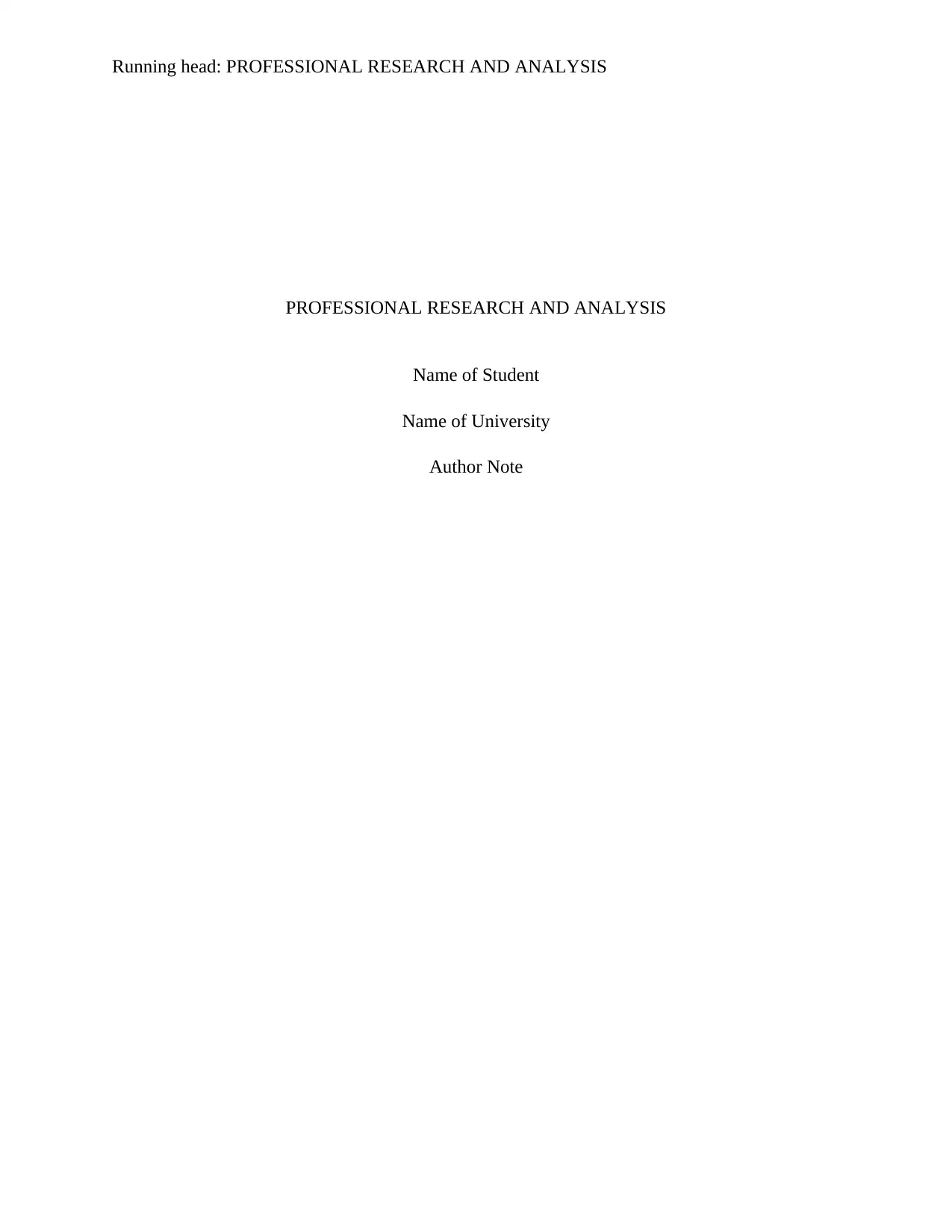
Running head: PROFESSIONAL RESEARCH AND ANALYSIS
PROFESSIONAL RESEARCH AND ANALYSIS
Name of Student
Name of University
Author Note
PROFESSIONAL RESEARCH AND ANALYSIS
Name of Student
Name of University
Author Note
Paraphrase This Document
Need a fresh take? Get an instant paraphrase of this document with our AI Paraphraser
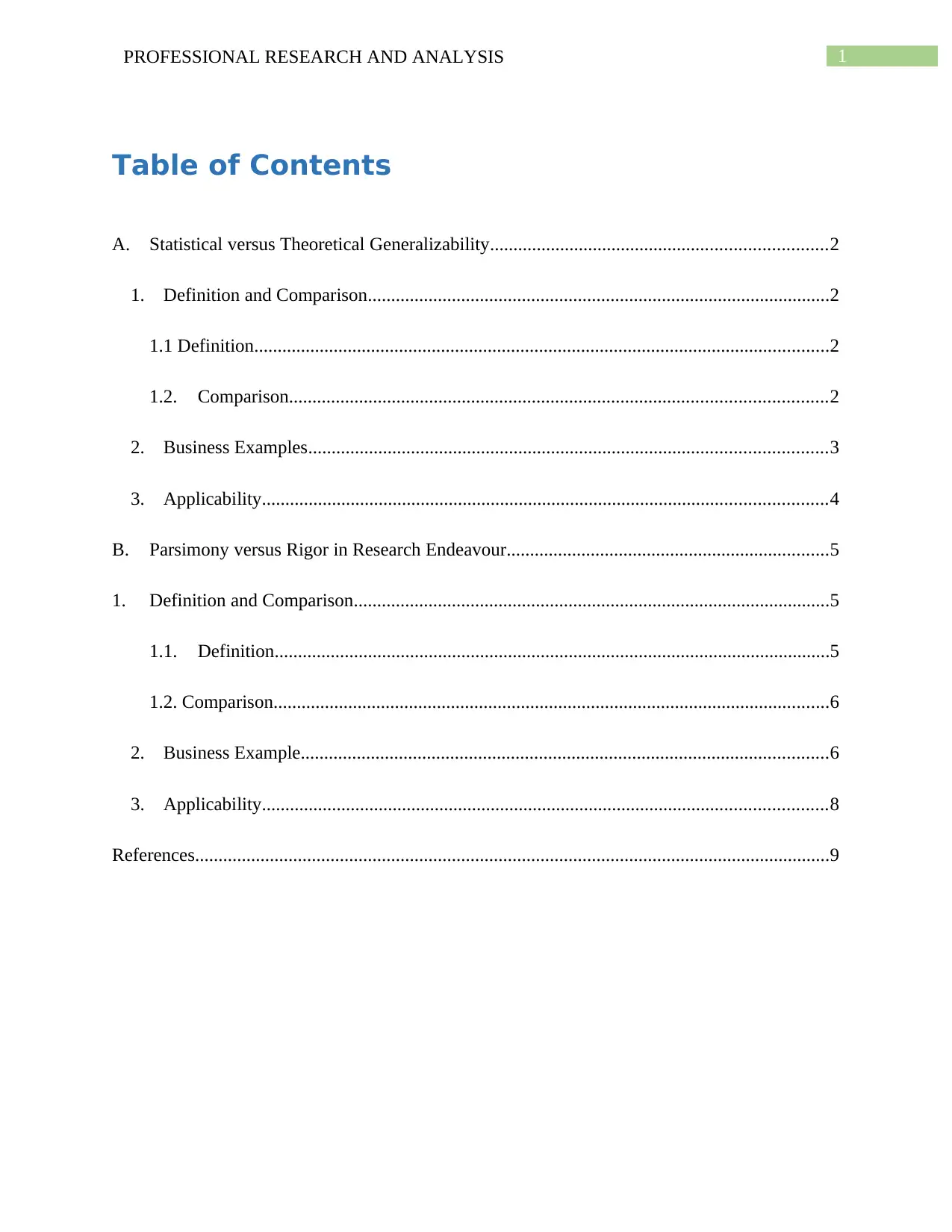
1PROFESSIONAL RESEARCH AND ANALYSIS
Table of Contents
A. Statistical versus Theoretical Generalizability........................................................................2
1. Definition and Comparison...................................................................................................2
1.1 Definition...........................................................................................................................2
1.2. Comparison...................................................................................................................2
2. Business Examples...............................................................................................................3
3. Applicability.........................................................................................................................4
B. Parsimony versus Rigor in Research Endeavour.....................................................................5
1. Definition and Comparison......................................................................................................5
1.1. Definition.......................................................................................................................5
1.2. Comparison.......................................................................................................................6
2. Business Example.................................................................................................................6
3. Applicability.........................................................................................................................8
References........................................................................................................................................9
Table of Contents
A. Statistical versus Theoretical Generalizability........................................................................2
1. Definition and Comparison...................................................................................................2
1.1 Definition...........................................................................................................................2
1.2. Comparison...................................................................................................................2
2. Business Examples...............................................................................................................3
3. Applicability.........................................................................................................................4
B. Parsimony versus Rigor in Research Endeavour.....................................................................5
1. Definition and Comparison......................................................................................................5
1.1. Definition.......................................................................................................................5
1.2. Comparison.......................................................................................................................6
2. Business Example.................................................................................................................6
3. Applicability.........................................................................................................................8
References........................................................................................................................................9
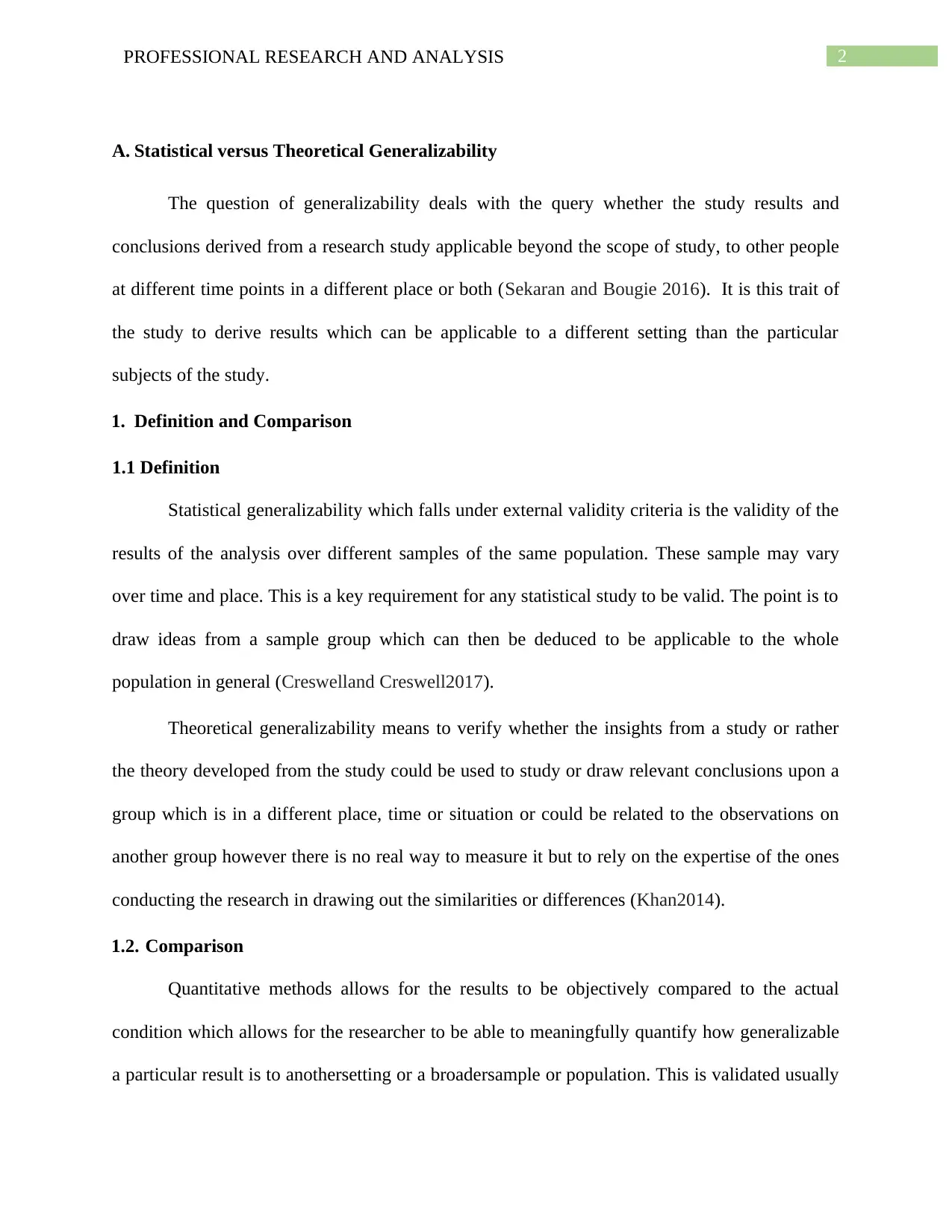
2PROFESSIONAL RESEARCH AND ANALYSIS
A. Statistical versus Theoretical Generalizability
The question of generalizability deals with the query whether the study results and
conclusions derived from a research study applicable beyond the scope of study, to other people
at different time points in a different place or both (Sekaran and Bougie 2016). It is this trait of
the study to derive results which can be applicable to a different setting than the particular
subjects of the study.
1. Definition and Comparison
1.1 Definition
Statistical generalizability which falls under external validity criteria is the validity of the
results of the analysis over different samples of the same population. These sample may vary
over time and place. This is a key requirement for any statistical study to be valid. The point is to
draw ideas from a sample group which can then be deduced to be applicable to the whole
population in general (Creswelland Creswell2017).
Theoretical generalizability means to verify whether the insights from a study or rather
the theory developed from the study could be used to study or draw relevant conclusions upon a
group which is in a different place, time or situation or could be related to the observations on
another group however there is no real way to measure it but to rely on the expertise of the ones
conducting the research in drawing out the similarities or differences (Khan2014).
1.2. Comparison
Quantitative methods allows for the results to be objectively compared to the actual
condition which allows for the researcher to be able to meaningfully quantify how generalizable
a particular result is to anothersetting or a broadersample or population. This is validated usually
A. Statistical versus Theoretical Generalizability
The question of generalizability deals with the query whether the study results and
conclusions derived from a research study applicable beyond the scope of study, to other people
at different time points in a different place or both (Sekaran and Bougie 2016). It is this trait of
the study to derive results which can be applicable to a different setting than the particular
subjects of the study.
1. Definition and Comparison
1.1 Definition
Statistical generalizability which falls under external validity criteria is the validity of the
results of the analysis over different samples of the same population. These sample may vary
over time and place. This is a key requirement for any statistical study to be valid. The point is to
draw ideas from a sample group which can then be deduced to be applicable to the whole
population in general (Creswelland Creswell2017).
Theoretical generalizability means to verify whether the insights from a study or rather
the theory developed from the study could be used to study or draw relevant conclusions upon a
group which is in a different place, time or situation or could be related to the observations on
another group however there is no real way to measure it but to rely on the expertise of the ones
conducting the research in drawing out the similarities or differences (Khan2014).
1.2. Comparison
Quantitative methods allows for the results to be objectively compared to the actual
condition which allows for the researcher to be able to meaningfully quantify how generalizable
a particular result is to anothersetting or a broadersample or population. This is validated usually
⊘ This is a preview!⊘
Do you want full access?
Subscribe today to unlock all pages.

Trusted by 1+ million students worldwide
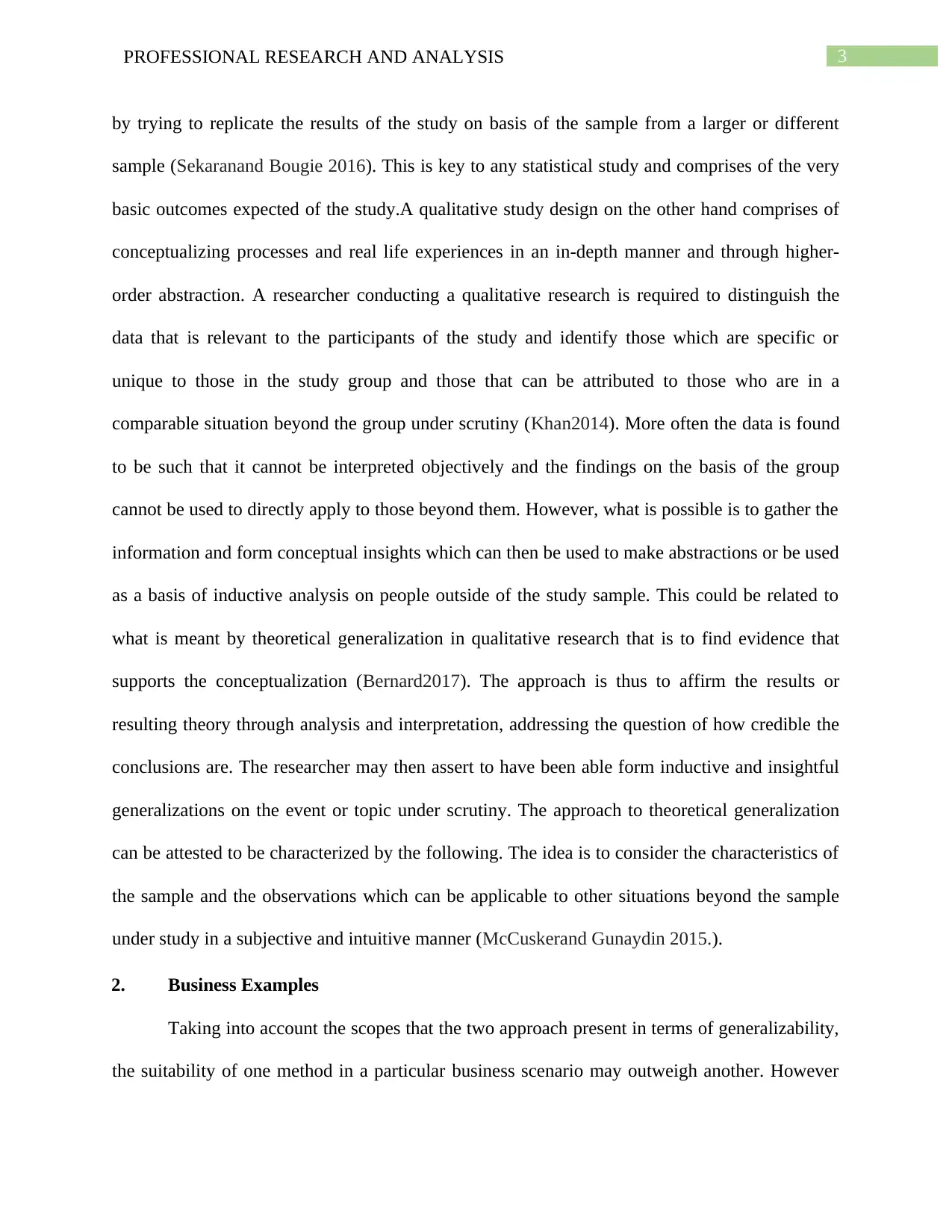
3PROFESSIONAL RESEARCH AND ANALYSIS
by trying to replicate the results of the study on basis of the sample from a larger or different
sample (Sekaranand Bougie 2016). This is key to any statistical study and comprises of the very
basic outcomes expected of the study.A qualitative study design on the other hand comprises of
conceptualizing processes and real life experiences in an in-depth manner and through higher-
order abstraction. A researcher conducting a qualitative research is required to distinguish the
data that is relevant to the participants of the study and identify those which are specific or
unique to those in the study group and those that can be attributed to those who are in a
comparable situation beyond the group under scrutiny (Khan2014). More often the data is found
to be such that it cannot be interpreted objectively and the findings on the basis of the group
cannot be used to directly apply to those beyond them. However, what is possible is to gather the
information and form conceptual insights which can then be used to make abstractions or be used
as a basis of inductive analysis on people outside of the study sample. This could be related to
what is meant by theoretical generalization in qualitative research that is to find evidence that
supports the conceptualization (Bernard2017). The approach is thus to affirm the results or
resulting theory through analysis and interpretation, addressing the question of how credible the
conclusions are. The researcher may then assert to have been able form inductive and insightful
generalizations on the event or topic under scrutiny. The approach to theoretical generalization
can be attested to be characterized by the following. The idea is to consider the characteristics of
the sample and the observations which can be applicable to other situations beyond the sample
under study in a subjective and intuitive manner (McCuskerand Gunaydin 2015.).
2. Business Examples
Taking into account the scopes that the two approach present in terms of generalizability,
the suitability of one method in a particular business scenario may outweigh another. However
by trying to replicate the results of the study on basis of the sample from a larger or different
sample (Sekaranand Bougie 2016). This is key to any statistical study and comprises of the very
basic outcomes expected of the study.A qualitative study design on the other hand comprises of
conceptualizing processes and real life experiences in an in-depth manner and through higher-
order abstraction. A researcher conducting a qualitative research is required to distinguish the
data that is relevant to the participants of the study and identify those which are specific or
unique to those in the study group and those that can be attributed to those who are in a
comparable situation beyond the group under scrutiny (Khan2014). More often the data is found
to be such that it cannot be interpreted objectively and the findings on the basis of the group
cannot be used to directly apply to those beyond them. However, what is possible is to gather the
information and form conceptual insights which can then be used to make abstractions or be used
as a basis of inductive analysis on people outside of the study sample. This could be related to
what is meant by theoretical generalization in qualitative research that is to find evidence that
supports the conceptualization (Bernard2017). The approach is thus to affirm the results or
resulting theory through analysis and interpretation, addressing the question of how credible the
conclusions are. The researcher may then assert to have been able form inductive and insightful
generalizations on the event or topic under scrutiny. The approach to theoretical generalization
can be attested to be characterized by the following. The idea is to consider the characteristics of
the sample and the observations which can be applicable to other situations beyond the sample
under study in a subjective and intuitive manner (McCuskerand Gunaydin 2015.).
2. Business Examples
Taking into account the scopes that the two approach present in terms of generalizability,
the suitability of one method in a particular business scenario may outweigh another. However
Paraphrase This Document
Need a fresh take? Get an instant paraphrase of this document with our AI Paraphraser
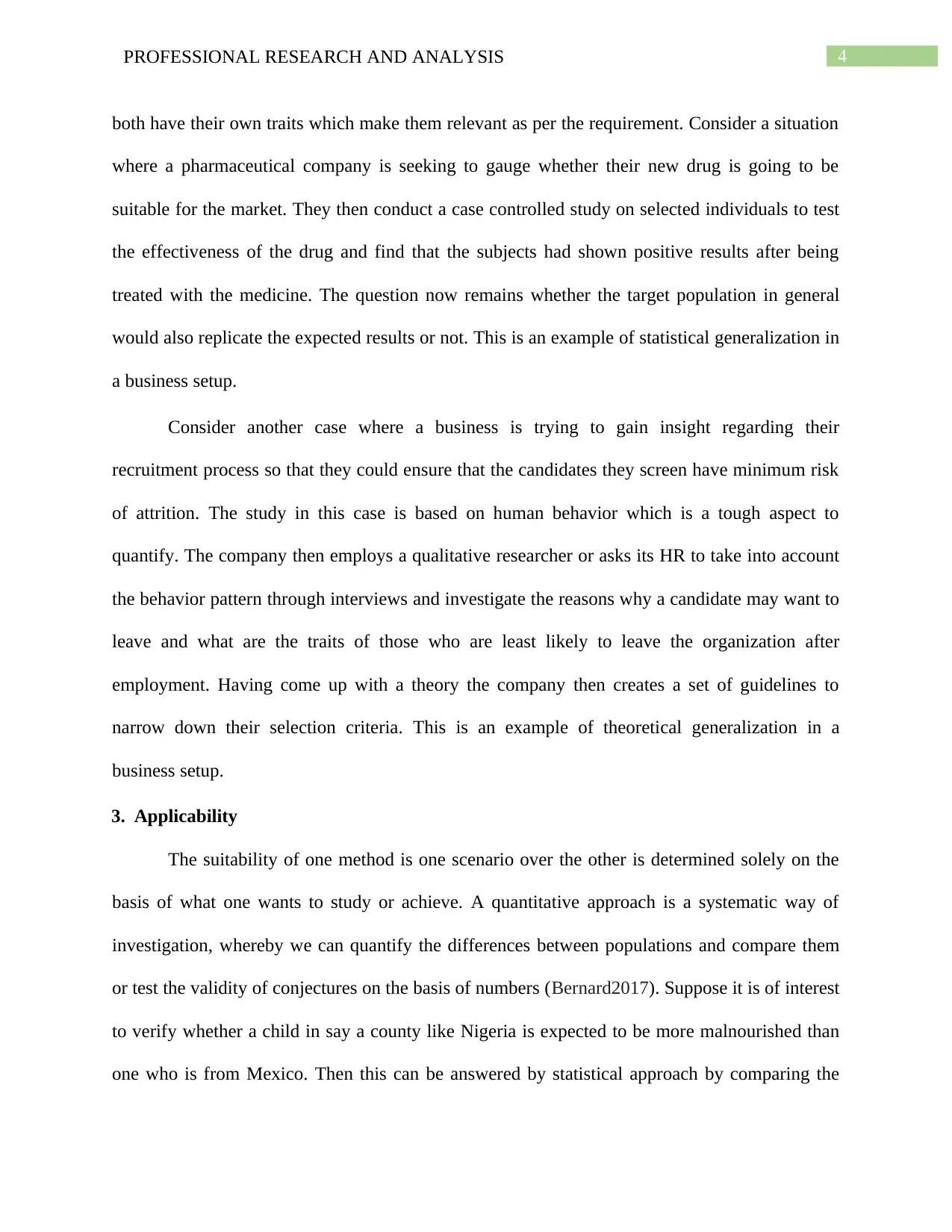
4PROFESSIONAL RESEARCH AND ANALYSIS
both have their own traits which make them relevant as per the requirement. Consider a situation
where a pharmaceutical company is seeking to gauge whether their new drug is going to be
suitable for the market. They then conduct a case controlled study on selected individuals to test
the effectiveness of the drug and find that the subjects had shown positive results after being
treated with the medicine. The question now remains whether the target population in general
would also replicate the expected results or not. This is an example of statistical generalization in
a business setup.
Consider another case where a business is trying to gain insight regarding their
recruitment process so that they could ensure that the candidates they screen have minimum risk
of attrition. The study in this case is based on human behavior which is a tough aspect to
quantify. The company then employs a qualitative researcher or asks its HR to take into account
the behavior pattern through interviews and investigate the reasons why a candidate may want to
leave and what are the traits of those who are least likely to leave the organization after
employment. Having come up with a theory the company then creates a set of guidelines to
narrow down their selection criteria. This is an example of theoretical generalization in a
business setup.
3. Applicability
The suitability of one method is one scenario over the other is determined solely on the
basis of what one wants to study or achieve. A quantitative approach is a systematic way of
investigation, whereby we can quantify the differences between populations and compare them
or test the validity of conjectures on the basis of numbers (Bernard2017). Suppose it is of interest
to verify whether a child in say a county like Nigeria is expected to be more malnourished than
one who is from Mexico. Then this can be answered by statistical approach by comparing the
both have their own traits which make them relevant as per the requirement. Consider a situation
where a pharmaceutical company is seeking to gauge whether their new drug is going to be
suitable for the market. They then conduct a case controlled study on selected individuals to test
the effectiveness of the drug and find that the subjects had shown positive results after being
treated with the medicine. The question now remains whether the target population in general
would also replicate the expected results or not. This is an example of statistical generalization in
a business setup.
Consider another case where a business is trying to gain insight regarding their
recruitment process so that they could ensure that the candidates they screen have minimum risk
of attrition. The study in this case is based on human behavior which is a tough aspect to
quantify. The company then employs a qualitative researcher or asks its HR to take into account
the behavior pattern through interviews and investigate the reasons why a candidate may want to
leave and what are the traits of those who are least likely to leave the organization after
employment. Having come up with a theory the company then creates a set of guidelines to
narrow down their selection criteria. This is an example of theoretical generalization in a
business setup.
3. Applicability
The suitability of one method is one scenario over the other is determined solely on the
basis of what one wants to study or achieve. A quantitative approach is a systematic way of
investigation, whereby we can quantify the differences between populations and compare them
or test the validity of conjectures on the basis of numbers (Bernard2017). Suppose it is of interest
to verify whether a child in say a county like Nigeria is expected to be more malnourished than
one who is from Mexico. Then this can be answered by statistical approach by comparing the
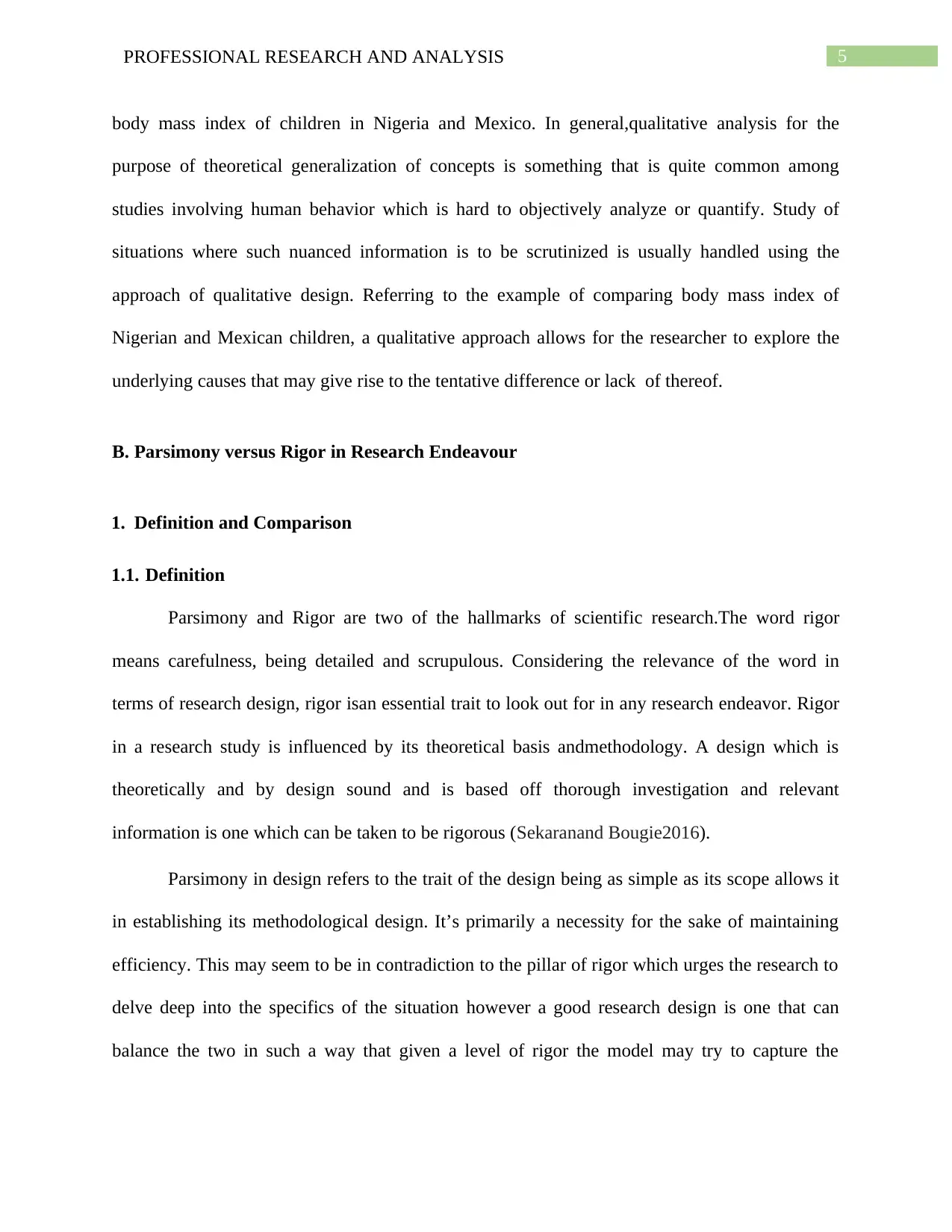
5PROFESSIONAL RESEARCH AND ANALYSIS
body mass index of children in Nigeria and Mexico. In general,qualitative analysis for the
purpose of theoretical generalization of concepts is something that is quite common among
studies involving human behavior which is hard to objectively analyze or quantify. Study of
situations where such nuanced information is to be scrutinized is usually handled using the
approach of qualitative design. Referring to the example of comparing body mass index of
Nigerian and Mexican children, a qualitative approach allows for the researcher to explore the
underlying causes that may give rise to the tentative difference or lack of thereof.
B. Parsimony versus Rigor in Research Endeavour
1. Definition and Comparison
1.1. Definition
Parsimony and Rigor are two of the hallmarks of scientific research.The word rigor
means carefulness, being detailed and scrupulous. Considering the relevance of the word in
terms of research design, rigor isan essential trait to look out for in any research endeavor. Rigor
in a research study is influenced by its theoretical basis andmethodology. A design which is
theoretically and by design sound and is based off thorough investigation and relevant
information is one which can be taken to be rigorous (Sekaranand Bougie2016).
Parsimony in design refers to the trait of the design being as simple as its scope allows it
in establishing its methodological design. It’s primarily a necessity for the sake of maintaining
efficiency. This may seem to be in contradiction to the pillar of rigor which urges the research to
delve deep into the specifics of the situation however a good research design is one that can
balance the two in such a way that given a level of rigor the model may try to capture the
body mass index of children in Nigeria and Mexico. In general,qualitative analysis for the
purpose of theoretical generalization of concepts is something that is quite common among
studies involving human behavior which is hard to objectively analyze or quantify. Study of
situations where such nuanced information is to be scrutinized is usually handled using the
approach of qualitative design. Referring to the example of comparing body mass index of
Nigerian and Mexican children, a qualitative approach allows for the researcher to explore the
underlying causes that may give rise to the tentative difference or lack of thereof.
B. Parsimony versus Rigor in Research Endeavour
1. Definition and Comparison
1.1. Definition
Parsimony and Rigor are two of the hallmarks of scientific research.The word rigor
means carefulness, being detailed and scrupulous. Considering the relevance of the word in
terms of research design, rigor isan essential trait to look out for in any research endeavor. Rigor
in a research study is influenced by its theoretical basis andmethodology. A design which is
theoretically and by design sound and is based off thorough investigation and relevant
information is one which can be taken to be rigorous (Sekaranand Bougie2016).
Parsimony in design refers to the trait of the design being as simple as its scope allows it
in establishing its methodological design. It’s primarily a necessity for the sake of maintaining
efficiency. This may seem to be in contradiction to the pillar of rigor which urges the research to
delve deep into the specifics of the situation however a good research design is one that can
balance the two in such a way that given a level of rigor the model may try to capture the
⊘ This is a preview!⊘
Do you want full access?
Subscribe today to unlock all pages.

Trusted by 1+ million students worldwide
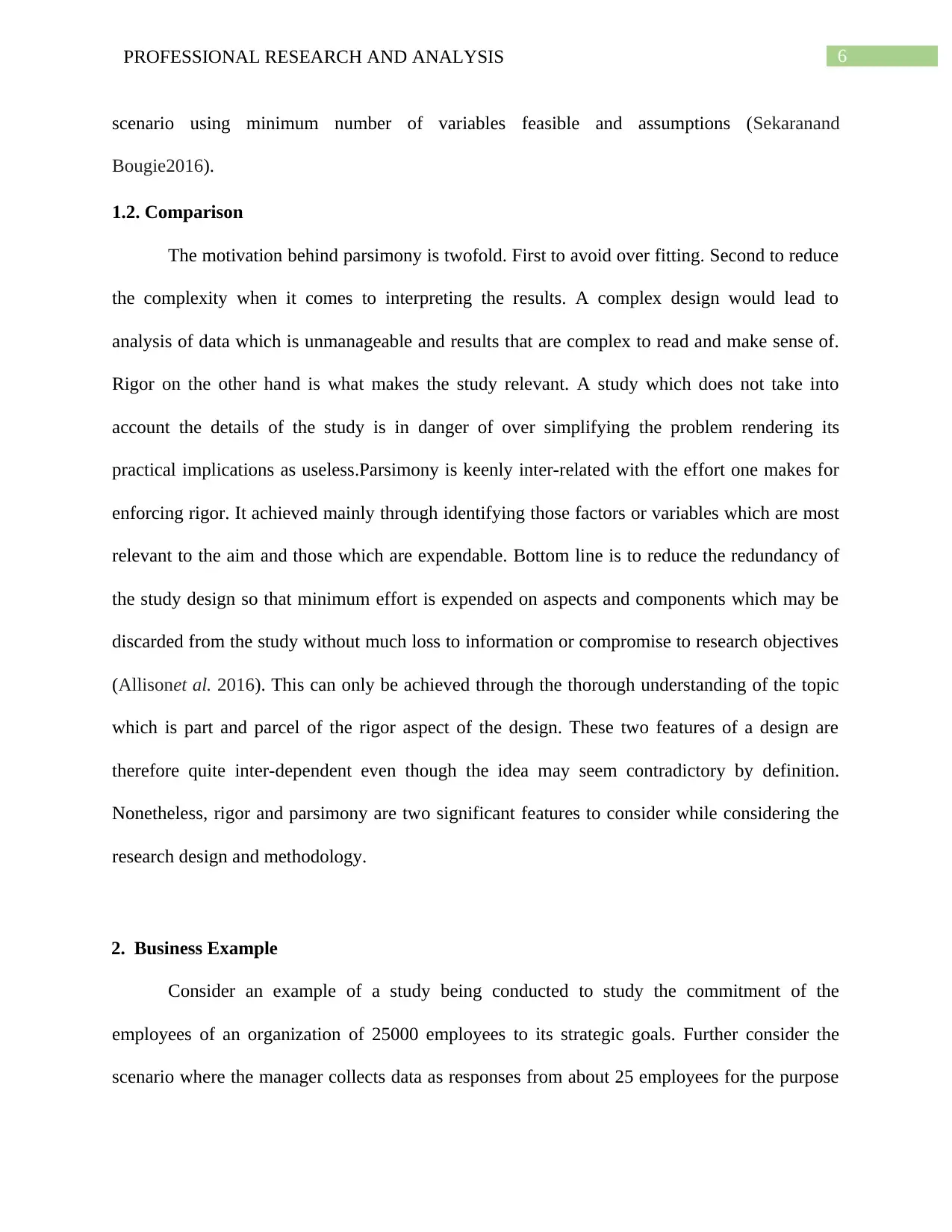
6PROFESSIONAL RESEARCH AND ANALYSIS
scenario using minimum number of variables feasible and assumptions (Sekaranand
Bougie2016).
1.2. Comparison
The motivation behind parsimony is twofold. First to avoid over fitting. Second to reduce
the complexity when it comes to interpreting the results. A complex design would lead to
analysis of data which is unmanageable and results that are complex to read and make sense of.
Rigor on the other hand is what makes the study relevant. A study which does not take into
account the details of the study is in danger of over simplifying the problem rendering its
practical implications as useless.Parsimony is keenly inter-related with the effort one makes for
enforcing rigor. It achieved mainly through identifying those factors or variables which are most
relevant to the aim and those which are expendable. Bottom line is to reduce the redundancy of
the study design so that minimum effort is expended on aspects and components which may be
discarded from the study without much loss to information or compromise to research objectives
(Allisonet al. 2016). This can only be achieved through the thorough understanding of the topic
which is part and parcel of the rigor aspect of the design. These two features of a design are
therefore quite inter-dependent even though the idea may seem contradictory by definition.
Nonetheless, rigor and parsimony are two significant features to consider while considering the
research design and methodology.
2. Business Example
Consider an example of a study being conducted to study the commitment of the
employees of an organization of 25000 employees to its strategic goals. Further consider the
scenario where the manager collects data as responses from about 25 employees for the purpose
scenario using minimum number of variables feasible and assumptions (Sekaranand
Bougie2016).
1.2. Comparison
The motivation behind parsimony is twofold. First to avoid over fitting. Second to reduce
the complexity when it comes to interpreting the results. A complex design would lead to
analysis of data which is unmanageable and results that are complex to read and make sense of.
Rigor on the other hand is what makes the study relevant. A study which does not take into
account the details of the study is in danger of over simplifying the problem rendering its
practical implications as useless.Parsimony is keenly inter-related with the effort one makes for
enforcing rigor. It achieved mainly through identifying those factors or variables which are most
relevant to the aim and those which are expendable. Bottom line is to reduce the redundancy of
the study design so that minimum effort is expended on aspects and components which may be
discarded from the study without much loss to information or compromise to research objectives
(Allisonet al. 2016). This can only be achieved through the thorough understanding of the topic
which is part and parcel of the rigor aspect of the design. These two features of a design are
therefore quite inter-dependent even though the idea may seem contradictory by definition.
Nonetheless, rigor and parsimony are two significant features to consider while considering the
research design and methodology.
2. Business Example
Consider an example of a study being conducted to study the commitment of the
employees of an organization of 25000 employees to its strategic goals. Further consider the
scenario where the manager collects data as responses from about 25 employees for the purpose
Paraphrase This Document
Need a fresh take? Get an instant paraphrase of this document with our AI Paraphraser
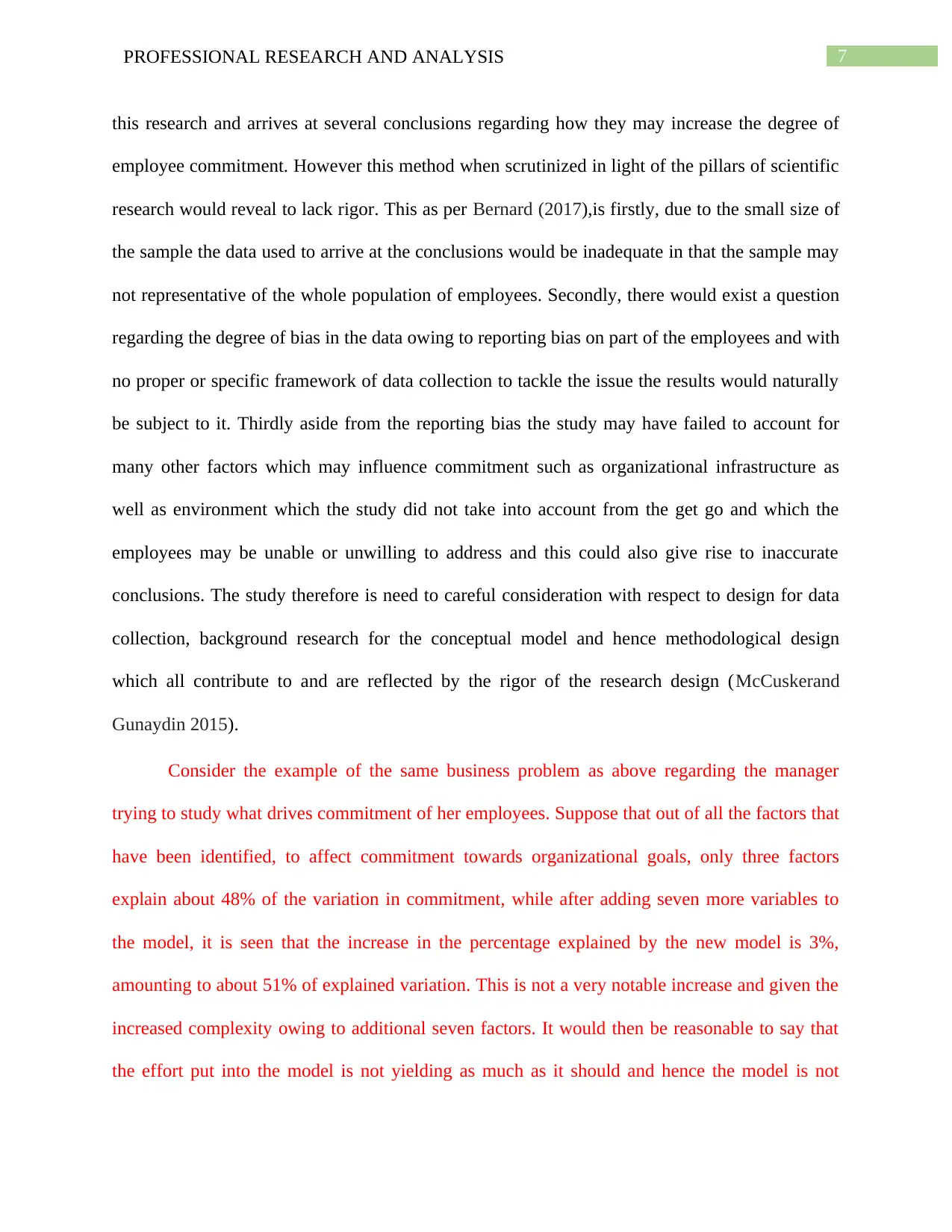
7PROFESSIONAL RESEARCH AND ANALYSIS
this research and arrives at several conclusions regarding how they may increase the degree of
employee commitment. However this method when scrutinized in light of the pillars of scientific
research would reveal to lack rigor. This as per Bernard (2017),is firstly, due to the small size of
the sample the data used to arrive at the conclusions would be inadequate in that the sample may
not representative of the whole population of employees. Secondly, there would exist a question
regarding the degree of bias in the data owing to reporting bias on part of the employees and with
no proper or specific framework of data collection to tackle the issue the results would naturally
be subject to it. Thirdly aside from the reporting bias the study may have failed to account for
many other factors which may influence commitment such as organizational infrastructure as
well as environment which the study did not take into account from the get go and which the
employees may be unable or unwilling to address and this could also give rise to inaccurate
conclusions. The study therefore is need to careful consideration with respect to design for data
collection, background research for the conceptual model and hence methodological design
which all contribute to and are reflected by the rigor of the research design (McCuskerand
Gunaydin 2015).
Consider the example of the same business problem as above regarding the manager
trying to study what drives commitment of her employees. Suppose that out of all the factors that
have been identified, to affect commitment towards organizational goals, only three factors
explain about 48% of the variation in commitment, while after adding seven more variables to
the model, it is seen that the increase in the percentage explained by the new model is 3%,
amounting to about 51% of explained variation. This is not a very notable increase and given the
increased complexity owing to additional seven factors. It would then be reasonable to say that
the effort put into the model is not yielding as much as it should and hence the model is not
this research and arrives at several conclusions regarding how they may increase the degree of
employee commitment. However this method when scrutinized in light of the pillars of scientific
research would reveal to lack rigor. This as per Bernard (2017),is firstly, due to the small size of
the sample the data used to arrive at the conclusions would be inadequate in that the sample may
not representative of the whole population of employees. Secondly, there would exist a question
regarding the degree of bias in the data owing to reporting bias on part of the employees and with
no proper or specific framework of data collection to tackle the issue the results would naturally
be subject to it. Thirdly aside from the reporting bias the study may have failed to account for
many other factors which may influence commitment such as organizational infrastructure as
well as environment which the study did not take into account from the get go and which the
employees may be unable or unwilling to address and this could also give rise to inaccurate
conclusions. The study therefore is need to careful consideration with respect to design for data
collection, background research for the conceptual model and hence methodological design
which all contribute to and are reflected by the rigor of the research design (McCuskerand
Gunaydin 2015).
Consider the example of the same business problem as above regarding the manager
trying to study what drives commitment of her employees. Suppose that out of all the factors that
have been identified, to affect commitment towards organizational goals, only three factors
explain about 48% of the variation in commitment, while after adding seven more variables to
the model, it is seen that the increase in the percentage explained by the new model is 3%,
amounting to about 51% of explained variation. This is not a very notable increase and given the
increased complexity owing to additional seven factors. It would then be reasonable to say that
the effort put into the model is not yielding as much as it should and hence the model is not
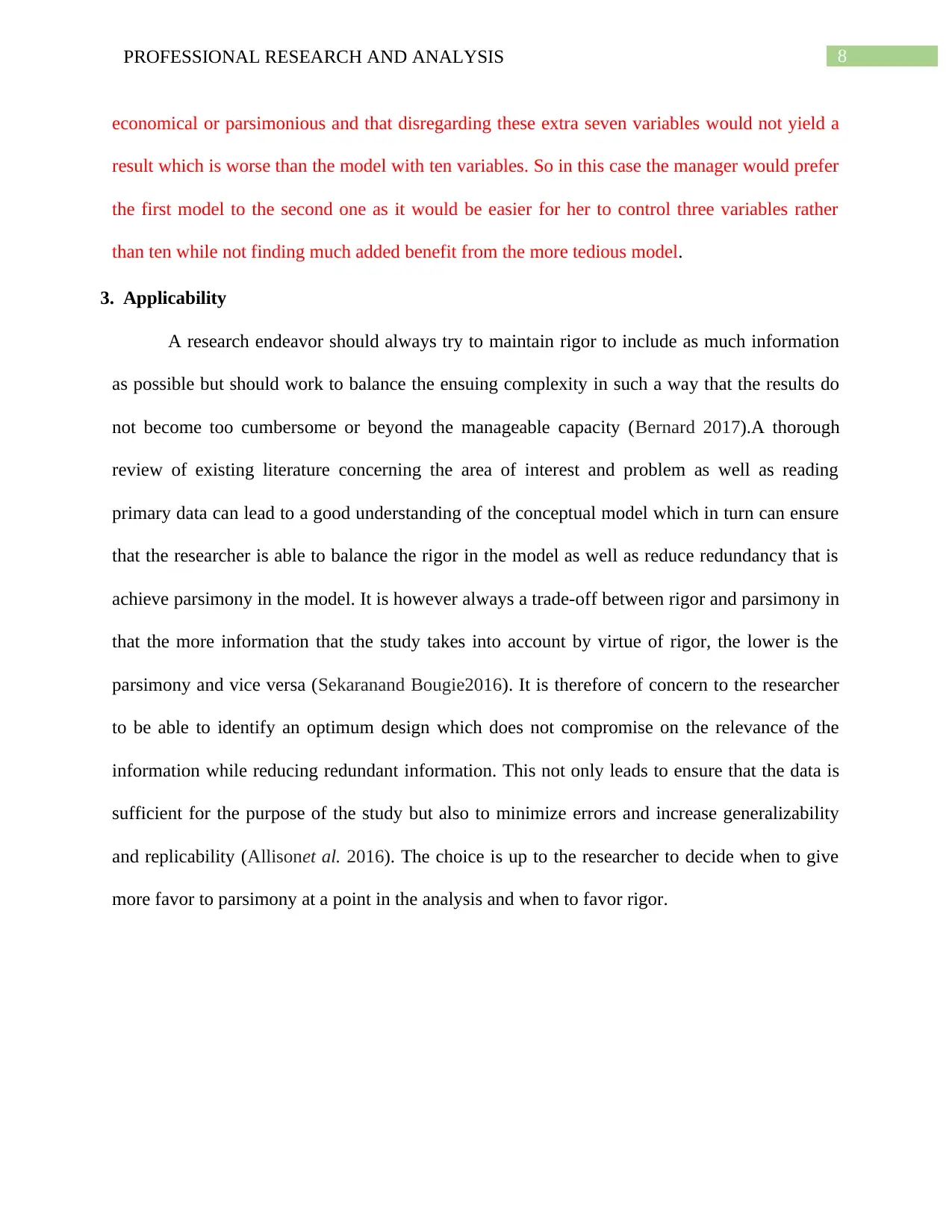
8PROFESSIONAL RESEARCH AND ANALYSIS
economical or parsimonious and that disregarding these extra seven variables would not yield a
result which is worse than the model with ten variables. So in this case the manager would prefer
the first model to the second one as it would be easier for her to control three variables rather
than ten while not finding much added benefit from the more tedious model.
3. Applicability
A research endeavor should always try to maintain rigor to include as much information
as possible but should work to balance the ensuing complexity in such a way that the results do
not become too cumbersome or beyond the manageable capacity (Bernard 2017).A thorough
review of existing literature concerning the area of interest and problem as well as reading
primary data can lead to a good understanding of the conceptual model which in turn can ensure
that the researcher is able to balance the rigor in the model as well as reduce redundancy that is
achieve parsimony in the model. It is however always a trade-off between rigor and parsimony in
that the more information that the study takes into account by virtue of rigor, the lower is the
parsimony and vice versa (Sekaranand Bougie2016). It is therefore of concern to the researcher
to be able to identify an optimum design which does not compromise on the relevance of the
information while reducing redundant information. This not only leads to ensure that the data is
sufficient for the purpose of the study but also to minimize errors and increase generalizability
and replicability (Allisonet al. 2016). The choice is up to the researcher to decide when to give
more favor to parsimony at a point in the analysis and when to favor rigor.
economical or parsimonious and that disregarding these extra seven variables would not yield a
result which is worse than the model with ten variables. So in this case the manager would prefer
the first model to the second one as it would be easier for her to control three variables rather
than ten while not finding much added benefit from the more tedious model.
3. Applicability
A research endeavor should always try to maintain rigor to include as much information
as possible but should work to balance the ensuing complexity in such a way that the results do
not become too cumbersome or beyond the manageable capacity (Bernard 2017).A thorough
review of existing literature concerning the area of interest and problem as well as reading
primary data can lead to a good understanding of the conceptual model which in turn can ensure
that the researcher is able to balance the rigor in the model as well as reduce redundancy that is
achieve parsimony in the model. It is however always a trade-off between rigor and parsimony in
that the more information that the study takes into account by virtue of rigor, the lower is the
parsimony and vice versa (Sekaranand Bougie2016). It is therefore of concern to the researcher
to be able to identify an optimum design which does not compromise on the relevance of the
information while reducing redundant information. This not only leads to ensure that the data is
sufficient for the purpose of the study but also to minimize errors and increase generalizability
and replicability (Allisonet al. 2016). The choice is up to the researcher to decide when to give
more favor to parsimony at a point in the analysis and when to favor rigor.
⊘ This is a preview!⊘
Do you want full access?
Subscribe today to unlock all pages.

Trusted by 1+ million students worldwide
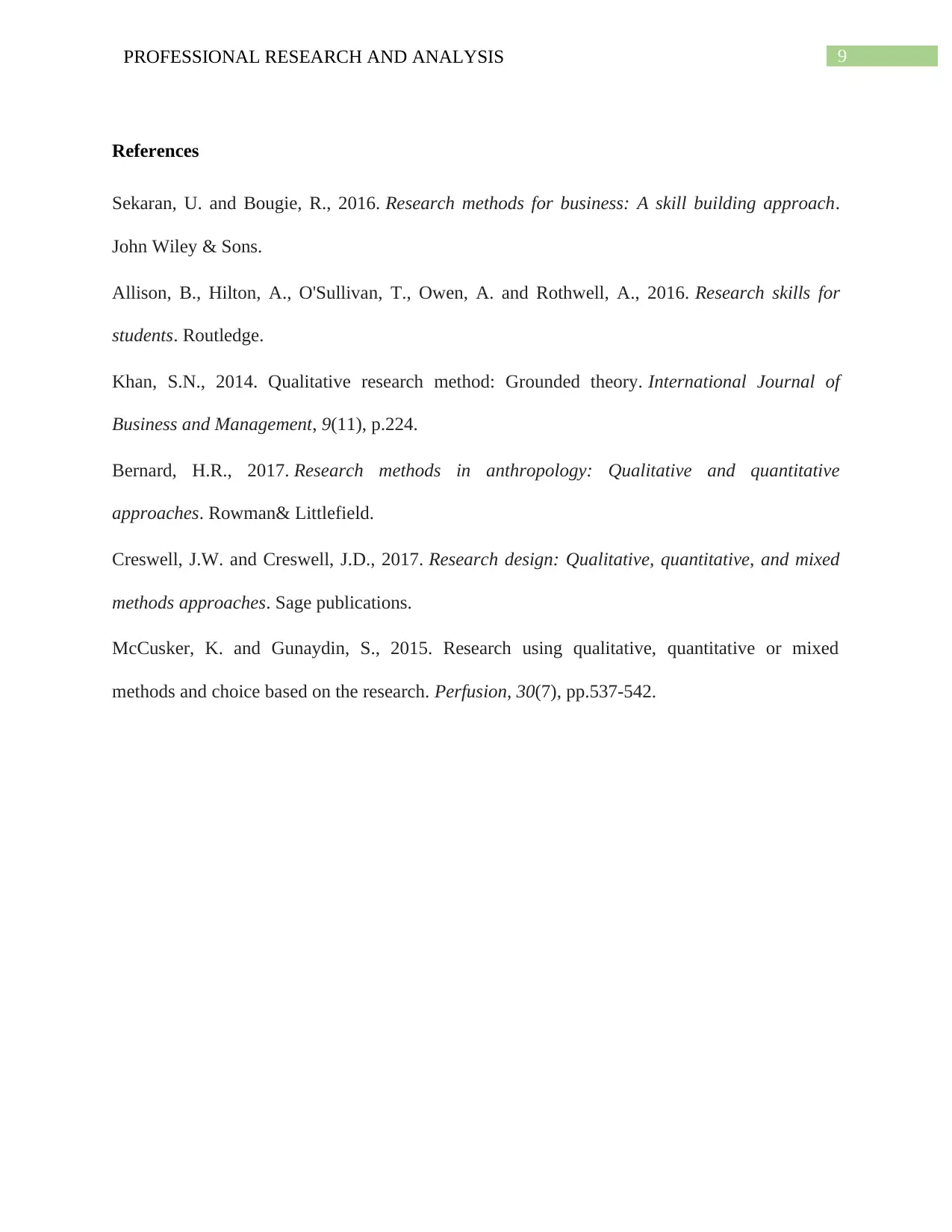
9PROFESSIONAL RESEARCH AND ANALYSIS
References
Sekaran, U. and Bougie, R., 2016. Research methods for business: A skill building approach.
John Wiley & Sons.
Allison, B., Hilton, A., O'Sullivan, T., Owen, A. and Rothwell, A., 2016. Research skills for
students. Routledge.
Khan, S.N., 2014. Qualitative research method: Grounded theory. International Journal of
Business and Management, 9(11), p.224.
Bernard, H.R., 2017. Research methods in anthropology: Qualitative and quantitative
approaches. Rowman& Littlefield.
Creswell, J.W. and Creswell, J.D., 2017. Research design: Qualitative, quantitative, and mixed
methods approaches. Sage publications.
McCusker, K. and Gunaydin, S., 2015. Research using qualitative, quantitative or mixed
methods and choice based on the research. Perfusion, 30(7), pp.537-542.
References
Sekaran, U. and Bougie, R., 2016. Research methods for business: A skill building approach.
John Wiley & Sons.
Allison, B., Hilton, A., O'Sullivan, T., Owen, A. and Rothwell, A., 2016. Research skills for
students. Routledge.
Khan, S.N., 2014. Qualitative research method: Grounded theory. International Journal of
Business and Management, 9(11), p.224.
Bernard, H.R., 2017. Research methods in anthropology: Qualitative and quantitative
approaches. Rowman& Littlefield.
Creswell, J.W. and Creswell, J.D., 2017. Research design: Qualitative, quantitative, and mixed
methods approaches. Sage publications.
McCusker, K. and Gunaydin, S., 2015. Research using qualitative, quantitative or mixed
methods and choice based on the research. Perfusion, 30(7), pp.537-542.
1 out of 10
Related Documents
Your All-in-One AI-Powered Toolkit for Academic Success.
+13062052269
info@desklib.com
Available 24*7 on WhatsApp / Email
![[object Object]](/_next/static/media/star-bottom.7253800d.svg)
Unlock your academic potential
Copyright © 2020–2025 A2Z Services. All Rights Reserved. Developed and managed by ZUCOL.




